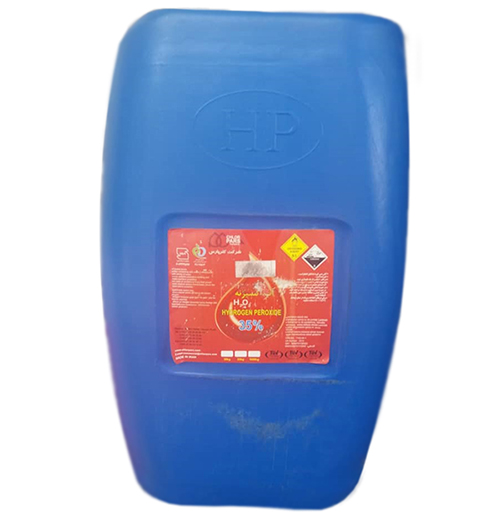Hydrogen peroxide persian 50 percent 65kg
Hydrogen peroxide is a chemical compound with the formula H2O In its pure form, it is a very pale blue liquid, slightly more viscous than water. Hydrogen peroxide is the simplest peroxide (a compound with an oxygen–oxygen single bond). It is used as an oxidizer, bleaching agent, and antiseptic. Concentrated hydrogen peroxide, or "high-test peroxide", is a reactive oxygen species and has been used as a propellant in rocketry.Its chemistry is dominated by the nature of its unstable peroxide bond.
Hydrogen peroxide is unstable and slowly decomposes in the presence of light. Because of its instability, hydrogen peroxide is typically stored with a stabilizer in a weakly acidic solution in a dark coloured bottle. Hydrogen peroxide is found in biological systems including the human body. Enzymes that use or decompose hydrogen peroxide are classified as peroxidases.
Discovery
Alexander von Humboldt reported one of the first synthetic peroxides, barium peroxide, in 1799 as a by-product of his attempts to decompose air.
Nineteen years later Louis Jacques Thénard recognized that this compound could be used for the preparation of a previously unknown compound, which he described as eau oxygénée ("oxygenated water") – subsequently known as hydrogen peroxide.Today this term refers instead to water containing dissolved oxygen (O2).
Persian Calcium Hypochlorite 25kg
Calcium oxychlorides
A confusion sometimes reigns between calcium oxychlorides and calcium hypochlorite. Indeed, the name calcium oxychloride (or calcium hydroxychloride) does not immediately refer to calcium hypochlorite, but is only applicable to the mixed calcium basic chloride compounds remaining unreacted in the bleaching powder, such as, e.g. CaCl2 · 2 Ca(OH)2.
Calcium oxychloride may also be formed in concrete in roads and bridges when calcium chloride is used as deicing agent during winter. Calcium chloride then reacts with calcium hydroxide (portlandite) present in cement hydration products and forms a deleterious expanding phase also named CAOXY (abbreviation for calcium oxychloride) by concrete technologists. The stress induced into concrete by crystallisation pressure and CAOXY salt expansion can considerably reduce the strength of concrete.
Chemical properties
Calcium hypochlorite exhibits both acido-basic and oxydo-reduction properties. It is a relatively strong base.
Calcium hypochlorite solution is basic as the hypochlorite anion can accept a proton from a water molecule leaving a hydroxyُl anion in solution. This basicity is due to the propensity for the hypochlorite anion to accept a proton to become hypochlorous acid, a weak acid:
- ClO− + H2O ↔ HClO + OH−
The hypochlorite anion is also a strong oxidizing agent containing a chlorine atom at the valence I (redox state: Cl+1) which reacts under acidic conditions with the reduced chloride species (Cl–, here the reducing agent) present in hydrochloric acid to form calcium chloride, water and gaseous chlorine. The overall reaction is:
- Ca(ClO)2 + 4 HCl → CaCl2 + 2 H2O + 2 Cl2
Persian Calcium Hypochlorite 30Kg
Calcium oxychlorides
A confusion sometimes reigns between calcium oxychlorides and calcium hypochlorite. Indeed, the name calcium oxychloride (or calcium hydroxychloride) does not immediately refer to calcium hypochlorite, but is only applicable to the mixed calcium basic chloride compounds remaining unreacted in the bleaching powder, such as, e.g. CaCl2 · 2 Ca(OH)2.
Calcium oxychloride may also be formed in concrete in roads and bridges when calcium chloride is used as deicing agent during winter. Calcium chloride then reacts with calcium hydroxide (portlandite) present in cement hydration products and forms a deleterious expanding phase also named CAOXY (abbreviation for calcium oxychloride) by concrete technologists. The stress induced into concrete by crystallisation pressure and CAOXY salt expansion can considerably reduce the strength of concrete.
Chemical properties
Calcium hypochlorite exhibits both acido-basic and oxydo-reduction properties. It is a relatively strong base.
Calcium hypochlorite solution is basic as the hypochlorite anion can accept a proton from a water molecule leaving a hydroxyُl anion in solution. This basicity is due to the propensity for the hypochlorite anion to accept a proton to become hypochlorous acid, a weak acid:
- ClO− + H2O ↔ HClO + OH−
The hypochlorite anion is also a strong oxidizing agent containing a chlorine atom at the valence I (redox state: Cl+1) which reacts under acidic conditions with the reduced chloride species (Cl–, here the reducing agent) present in hydrochloric acid to form calcium chloride, water and gaseous chlorine. The overall reaction is:
- Ca(ClO)2 + 4 HCl → CaCl2 + 2 H2O + 2 Cl2






